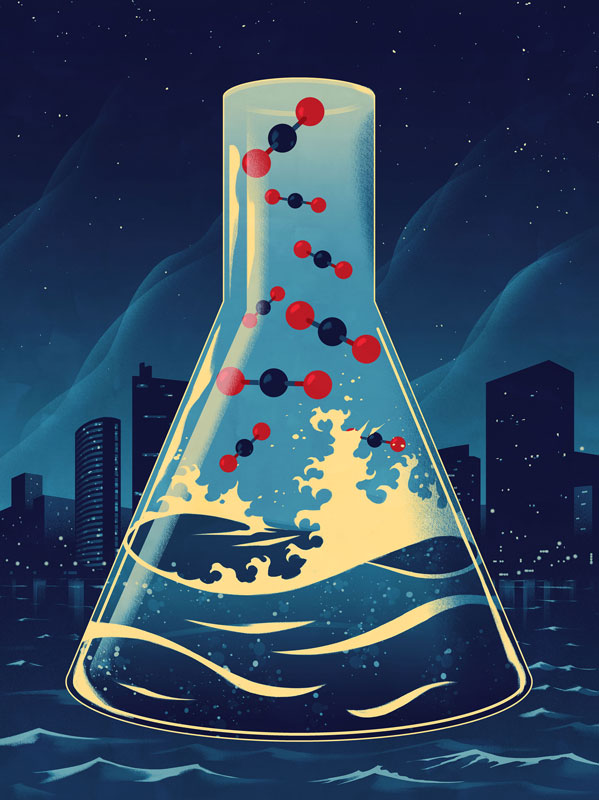Their potential for carbon capture is huge – but so are the unknowns…
Water covers 70 percent of our planet, but you probably already knew that. What fewer people know is that our oceans absorb around one quarter of human-made carbon dioxide emissions. To put it another way, the ocean is already our largest carbon sink—and it could potentially be leveraged to pull even more CO2 out of the air and safely store it. But first we have some important questions to answer.
“Doing projects on land is the obvious place to look first when we’re trying to remove carbon, and the ocean is the next frontier,” says Katie Lebling, an Associate in the World Resources Institute’s (WRI) Climate Program, who recently authored a WRI report looking at responsibly scaling up ocean carbon dioxide removal.
Indeed, huge amounts of resources are being invested in direct air capture and storage technologies that actively extract CO2 from the atmosphere and store it elsewhere, such as underground or in materials. But this process is expensive and energy intensive today. Combined with the need to develop a range of carbon removal options, this has led to a growing focus on removing CO2 from our oceans. Already, Lebling says, tens of millions of dollars are being invested in nascent technologies that aim to do just this. A raft of start-ups are emerging, some boasting high-profile corporate investors and partners.
Fundamentally, all ocean-based carbon dioxide removal approaches tap into the natural ocean processes that absorb CO2 from the atmosphere. Once the dissolved CO2 from the seawater is removed through biological or chemical processes, the oceans absorb additional CO2 from the atmosphere to replace it.

There are dozens of ways to enhance or accelerate this. One category of approaches is biotic, which covers those that rely on cultivating photosynthesizing organisms such as seaweed to store the dissolved carbon dioxide as biomass. By adding nutrients to the ocean (a process called “ocean fertilization”) or moving deeper, nutrient-rich water to the surface (“artificial upwelling”), climate scientists can increase the population of phytoplankton that take up dissolved CO2. Then there are abiotic approaches, which are about changing the ocean’s physical or chemical properties. One option is to add alkaline minerals to ocean water, which react with dissolved CO2 and lock it away as a solid carbonate—a process known as alkalinity enhancement.
Another type of approach, electrochemical extraction of CO2, is receiving particular interest right now. Electrodialysis involves passing water between two plates before applying electricity to convert bicarbonates in the water to molecules of CO2. These can then be removed under vacuum conditions and either buried under the sea floor or converted into specialistic chemicals such as synthetic fuel. The concentration of carbon dioxide in seawater is more than a hundred times greater than in air per unit volume, so electrodialysis has the potential to be more efficient compared to direct air capture. Whether it uses less energy overall, though, is unclear.
As with alkalinity enhancement, one further benefit of electrodialysis is that it could help reduce acidification. When CO2 dissolves in seawater, the water becomes more acidic which negatively impacts marine creatures with shells and skeletons of calcium carbonate, because these more readily dissolve in acidic conditions. Shellfish, urchins, corals, and plankton suffer, as do some fish who find it harder to detect predators. By reinjecting alkaline water, electrodialysis can slowly start to reverse this effect, at least locally.
But while ocean carbon removal approaches provide huge potential, they present “a whole set of new risks and uncertainties”, says Lebling. For instance, it’s unclear how they will affect ocean ecosystems in the long term. “We have such a low level of understanding about the ocean,” she continues. “Ecological and environmental impacts can show up a year after you do the project. They can show up in a different location. So it can be really hard to tell what impact they’re having.”
As much as there’s a tendency to be more accepting of approaches that seem more natural, like growing seaweed, it’s important to understand that these also pose ecological and environmental risks depending on the scale and location of their implementation, among other factors.
There are also questions around the efficacy of these approaches. The ocean’s ability to draw CO2 from the atmosphere relies on Henry’s Law, which says that there must be an equilibrium between the atmospheric concentration of a gas and its concentration in the ocean.
“Still, though, there are a lot of questions about how long that equilibrium takes, and how that changes in different locations,” says Lebling. “If the ocean water circulates so the CO2 depleted water moves down and it doesn't equilibrate, then there hasn’t been any CO2 removed from the air.”
To resolve these uncertainties is going to take time and more investment in research. “But if we are able to start making these investments today,” says Lebling, “it could really pay off in the coming decades.”


